

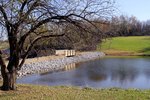
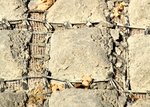

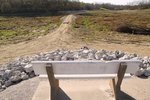
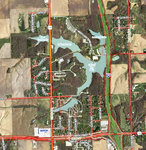


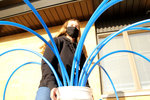
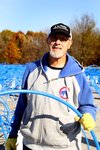
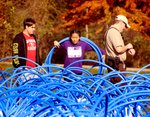
Water will once again cover West Lake Park’s lake bottoms by late spring following a $3.76 million restoration that has grown to include the private Lake Canyada, next door.
Excavation teams are digging the network of lakes a little deeper, stabilizing shorelines and adding submerged habitat that will improve fishing odds tremendously, for both the angler and the fish.
“If you stand in waist-high water, you should be able to see your toes,” Iowa Department of Natural Resources senior environmental specialist Michelle Balmer said.
Balmer is part of the team working with the Scott County Conservation department to change the murky, shallow lakes into a fishery more like Lost Grove Lake.
They’re getting help from community group volunteers, including QC In-Fishermen, and North Scott FFA, who built hundreds of fake plants anchored in five-gallon buckets. By next year, 600 concrete-filled buckets will anchor a canopy of free-flowing plastic tubes under 10-20 feet of water that will protect thousands of small fish to be stocked by the Iowa Department of Natural Resources.
For fish, the cover allows those small fry longer time to grow. For anglers, those flexible tubes are more forgiving of snags.
Excavation and shore stabilization work is expected to wrap up in May. Then rainfall will determine how quickly the nine-lake complex refills, Scott County Conservation director Roger Kean said.
“It won’t start filling until spring. Snow runoff and spring rains will be the deciding factors. I think it probably will be a year-long process,” Kean said.
He’s not sure about opening the beach in 2021. “We’re kind of uncertain what kind of activities we can have next summer,” he said.
“It’s amazing when you get even just a two- or four-inch rain in the spring, the amount of water that comes, even in this small watershed. It could fill a lot faster than people think.”
Fishing remains at least a season away. Better fishing is a few years down the road, he said.
Iowa’s DNR will stock the big lake, Lake of the Hills, and surrounding ponds on county and private property, Kean said.
“Out of nine ponds, four of them we’re stocking fish into. We don’t know how good a fishery they’ll be. But it does give the ability to have enough water there so they won’t freeze,” Kean said.
“We’ll put bass and blue gill and catfish in those little ponds and those within the park,” he said.
Private land owners agreed to allow retention work in and around those ponds to keep silt out of West Lake park’s waters. Kean said their collaboration was essential to keep the county lakes from silting in again.
Fish habitat
Kean and conservation department deputy director Marc Miller said the retention work will make Lake of the Hills and the park’s other lakes clearer, better for game fish that will flourish beneath new, underwater habitat.
The restoration added mounds of trees removed elsewhere in the park as part of the project. Those trees will be cabled in deeper areas to provide fish habitat.
Elsewhere, fish can thrive beneath a canopy of 600 artificial plants, including 100 made by North Scott FFA students. Each plant is a dozen six-foot lengths of tubing anchored by cement in a five-gallon bucket.
Kean said Scott County borrowed the tube idea from other DNR projects, where they proved more effective than tires, pallets and other recycled structures.
Lancer FFA member Evelyn Bauer filled more than a few of the buckets and lugged them to dry outside the high school FFA classroom. Those underwater plumes will provide fish homes for decades. FFA advisor Jacob Hunter thought the work fit the students’ civic engagement goals. The students were skeptical, at first.
“When Mr. Hunter said 100, I thought, ‘No way,’” Bauer said. After they were assembled outside the school, she mused that this habitat will be around longer than the students.
“We’ll never see them again. But they’ll make a big change in the lake,” she said.
Gary Gruenhagen, of Eldridge, was among the fishermen volunteering to build more at West Lake Park, Nov. 2. He, too, relished an opportunity to join in the restoration work.
“This will make the kind of difference it did at Lost Grove Lake,” he said. In Fishermen and other groups helped the DNR create underwater habitat when that lake was built.
DNR environmental specialist Balmer was involved in that project, too.
She recalled the deep community support for lake recreation in Scott County, and said it factored in DNR decisions to restore the lakes.
The West Lake Park work is funded by the state legislature’s annual appropriation for DNR lake restoration.
“We have one of the very few programs across country that allows for state funding of lake restoration,” Balmer said. The 14-year-old program has been funded at just over $8 million annually to methodically improve state and county public lakes.
“Lake of Hills had been on our radar for quite a while. It’s a high-use lake. People like going there.”
That will include Balmer.
The DeWitt native is more familiar with Scott County Park, but studied West Lake Park uses when developing the plan.
“I’m pumped to see the triathlon come back in a year or two. I told Marc and Roger that I’ll do it,” she said.
Lake Canyada added to project
The restoration work was expanded in November to include Lake Canyada. The new owners were eager to join, and agreed to cover 15 percent, or more than half of the local share required for the DNR’s estimated $250,000 to improve the dam, Kean said.
A DNR memo said the work benefits West Lake as much as the private Lake Canyada properties.
“Lake Canyada has a large population of rough fish (carp and buffalo), which threatened the success of the overall restoration project, as one element of the project is to eradicate the rough fish population from the watershed. Rough fish stir up bottom sediments and compete for resources within the lake, leading to lower water clarity and nutrient re-suspension.
“Removing rough fish from Lake Canyada through a draw down is critical to the project’s overall success. Additionally, the dam at Lake Canyada has a history of frequently overtopping one of the park roads after heavy rainfall events. Rehabilitating the dam will allow for better water level control and has the potential to reduce overtopping events.”
The conservation board approved up to $255,270.10 for Lake Canyada work, with a limit of $191,452.50 from the county and $63,817.60 from DNR.
Lake Canyada’s owner, Peek Group, LLC, has agreed to pick up 15 percent of the entire cost, Kean said.
The owner will benefit from a new flood gate, and fish stock from the DNR. County residents will get better flow control to keep Lake Canyada sediment out of county-owned lakes.
“If the owner is willing to go in and dredge that in the future, that takes that expense off of us. We’ve agreed to kill off all fish in there, and we will restock. It’s really good we have willing landowners,” Kean said.
Kean welcomed the support from Peek Group LLC, which bought the property Feb. 12, 2019 from Kevin Conklin for an undisclosed amount. The LLC is represented by Calvin Moss, of 2395 Tech Drive, Bettendorf.
Kean said the private park relied on the county park’s sewer treatment for years, a burden on the conservation board’s system. The county alerted the park owners in 2010 that it would end sewage treatment services. The last mobile home was removed in 2015.
The mobile home park operated 14 years under Lake Canyada LLC, which bought the property in 2001 for $1.95 million.
VFC Partners 34 LLC bought it in 2015 for an undisclosed amount, then sold it in 2016 to Jones & Sons LLC for $350,000.
Jones & Sons sold it to Conklin in 2018 for $925,000.